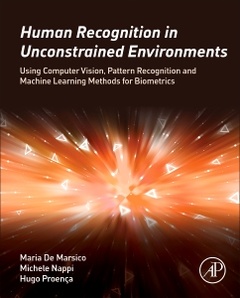Human Recognition in Unconstrained Environments Using Computer Vision, Pattern Recognition and Machine Learning Methods for Biometrics
Coordonnateurs : De Marsico Maria, Nappi Michele, Proença Hugo Pedro

Human Recognition in Unconstrained Environments provides a unique picture of the complete ?in-the-wild? biometric recognition processing chain; from data acquisition through to detection, segmentation, encoding, and matching reactions against security incidents.
Coverage includes:
- Data hardware architecture fundamentals
- Background subtraction of humans in outdoor scenes
- Camera synchronization
- Biometric traits: Real-time detection and data segmentation
- Biometric traits: Feature encoding / matching
- Fusion at different levels
- Reaction against security incidents
- Ethical issues in non-cooperative biometric recognition in public spaces
- Use computer vision, pattern recognition and machine learning methods for biometric recognition in real-world, real-time settings, especially those related to forensics and security
- Choose the most suited biometric traits and recognition methods for uncontrolled settings
- Evaluate the performance of a biometric system on real world data
With this book readers will learn how to:
1. Iris Recognition on Mobile Devices Using Near-Infrared Images 2. Face recognition using dictionary learning and domain adaptation 3. Periocular Recognition in Non-ideal Images 4. Real Time 3D Face-Ear Recognition on Mobile Devices: New Scenarios for 3D Biometricks “in-the-Wild 5. Fingerphoto Recognition in Outdoor Environment using Smartphones 6. Soft biometric labels in the wild. Case study on gender classification 7. Unconstrained data acquisition frameworks and protocols 8. Biometric Authentication to Access Controlled Areas through Eye Tracking 9. Non-cooperative biometrics: Cross-Jurisdictional concerns 10. Pattern Recognition and Machine Learning Methods for assessing the quality of fingerprints
University and industry R&D Engineers researching into pattern recognition, computer vision and machine learning methods applied to biometric system development.
Michele Nappi received the laurea degree (cum laude) in computer science from the University of Salerno, Salerno, Italy, in 1991, the M.Sc. degree in information and communication technology from I.I.A.S.S. "E.R. Caianiello", Vietri sul Mare, Salerno, and the Ph.D. degree in applied mathematics and computer science from the University of Padova, Padova, Italy. He is currently an Associate Professor of computer science at the University of Salerno.
His research interests include Multibiometric Systems, Pattern Recognition, Image Processing, Compression and Indexing, Multimedia Databases, Human-Computer Interaction, VR/AR. He co-authored over 120 papers in international conference, peer review journals and book chapters in these fields (see http://www.informatik.uni-trier.de/~ley/pers/hd/n/Nappi:Michele.html). He also served as Guest Editor for several international journals and as Editor for International Books. In 2014 He was one of the founders of the spin off BS3 (Biometric System for Security and
- Presents a complete picture of the biometric recognition processing chain, ranging from data acquisition to the reaction procedures against security incidents
- Provides specific requirements and issues behind each typical phase of the development of a robust biometric recognition system
- Includes a contextualization of the ethical/privacy issues behind the development of a covert recognition system which can be used for forensics and security activities
Date de parution : 01-2017
Ouvrage de 248 p.
19x23.3 cm
